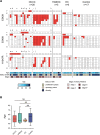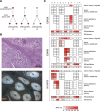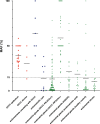Frequent PIK3CA mutations in eutopic endometrium of patients with ovarian clear cell carcinoma
- PMID: 34172890
- PMCID: PMC8514336
- DOI: 10.1038/s41379-021-00861-3
Frequent PIK3CA mutations in eutopic endometrium of patients with ovarian clear cell carcinoma
Abstract
Recent studies have reported cancer-associated mutations in normal endometrium. Mutations in eutopic endometrium may lead to endometriosis and endometriosis-associated ovarian cancer. We investigated PIK3CA mutations (PIK3CAm) for three hotspots (E542K, E545K, H1047R) in eutopic endometrium in patients with ovarian cancer and endometriosis from formalin-fixed paraffin-embedded specimens by laser-capture microdissection and droplet digital PCR. The presence of PIK3CAm in eutopic endometrial glands with mutant allele frequency ≥ 15% were as follows: ovarian clear cell carcinoma (OCCC) with PIK3CAm in tumors, 20/300 hotspots in 11/14 cases; OCCC without PIK3CAm, 42/78 hotspots in 11/12 cases; high-grade serous ovarian carcinoma, 8/45 hotspots in 3/5 cases; and endometriotic cysts, 5/63 hotspots in 5/6 cases. These rates were more frequent than in noncancer nonendometriosis controls (7/309 hotspots in 5/17 cases). In OCCC without PIK3CAm, 7/12 (58%) cases showed multiple hotspot mutations in the same eutopic endometrial glands. In 3/54 (5.6%) cases, PIK3CAm was found in eutopic endometrial stroma. Multisampling of the OCCC tumors with PIK3CAm showed intratumor heterogeneity in three of eight cases. In two cases, PIK3CAm was detected in the stromal component of the tumor. Homogenous PIK3CAm in the epithelial component of the tumor matched the mutation in eutopic endometrial glands in only one case. Eutopic endometrial glands in ovarian cancer and endometriosis show high frequency of PIK3CAm that is not consistent with tumors, and multiple hotspot mutations are often found in the same glands. While the mutations identified in eutopic endometrium may not be driver mutations in the patient's cancer, these are still driver mutations but this specific clone has not undergone the requisite steps for the development of cancer.
© 2021. The Author(s).
Conflict of interest statement
The authors declare no competing interests.
Figures




Similar articles
-
Clonal lineage from normal endometrium to ovarian clear cell carcinoma through ovarian endometriosis.Cancer Sci. 2020 Aug;111(8):3000-3009. doi: 10.1111/cas.14507. Epub 2020 Jun 26. Cancer Sci. 2020. PMID: 32473611 Free PMC article.
-
Targeted next-generation sequencing for molecular diagnosis of endometriosis-associated ovarian cancer.J Mol Med (Berl). 2016 Jul;94(7):835-47. doi: 10.1007/s00109-016-1395-2. Epub 2016 Feb 27. J Mol Med (Berl). 2016. PMID: 26920370
-
[Epigenetic inactivation of SPOCK2 in the malignant transformation of ovarian endometriosis].Zhonghua Fu Chan Ke Za Zhi. 2011 Nov;46(11):822-5. Zhonghua Fu Chan Ke Za Zhi. 2011. PMID: 22333230 Chinese.
-
Cancer-associated mutations in endometriosis: shedding light on the pathogenesis and pathophysiology.Hum Reprod Update. 2020 Apr 15;26(3):423-449. doi: 10.1093/humupd/dmz047. Hum Reprod Update. 2020. PMID: 32154564 Review.
-
Endometriosis-associated Ovarian Cancers.Clin Obstet Gynecol. 2017 Dec;60(4):711-727. doi: 10.1097/GRF.0000000000000320. Clin Obstet Gynecol. 2017. PMID: 28990985 Review.
Cited by
-
New Understanding of Diagnosis, Treatment and Prevention of Endometriosis.Int J Environ Res Public Health. 2022 May 31;19(11):6725. doi: 10.3390/ijerph19116725. Int J Environ Res Public Health. 2022. PMID: 35682310 Free PMC article. Review.
-
The "Road" to Malignant Transformation from Endometriosis to Endometriosis-Associated Ovarian Cancers (EAOCs): An mTOR-Centred Review.Cancers (Basel). 2024 Jun 6;16(11):2160. doi: 10.3390/cancers16112160. Cancers (Basel). 2024. PMID: 38893278 Free PMC article. Review.
-
Overexpression of FOS enhances the malignant potential of eutopic endometrial stromal cells in patients with endometriosis‑associated ovarian cancer.Oncol Rep. 2025 Apr;53(4):45. doi: 10.3892/or.2025.8878. Epub 2025 Feb 21. Oncol Rep. 2025. PMID: 39981914 Free PMC article.
-
Epithelial characteristics of ovarian clear cell carcinoma at single-cell resolution.Commun Biol. 2025 Aug 5;8(1):1156. doi: 10.1038/s42003-025-08617-4. Commun Biol. 2025. PMID: 40764744 Free PMC article.
-
Frequent PIK3CA mutation in normal endometrial gland drives spheroid formation and may be involved in stem cell propagation.Cancer Sci. 2023 Jun;114(6):2335-2344. doi: 10.1111/cas.15767. Epub 2023 Mar 12. Cancer Sci. 2023. PMID: 36843384 Free PMC article.
References
-
- Irving J, Clement P. Disease of the peritoneum. In: Kurman RJ, Ellenson LH, Ronnett BM, editors. Blaustein’s pathology of the female genital tract. 7th ed. New York, NY: Springer; 2019. p. 816–20.
Publication types
MeSH terms
Substances
LinkOut - more resources
Full Text Sources
Medical
Miscellaneous

